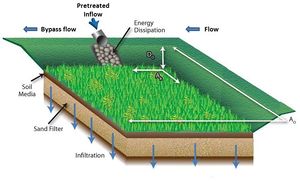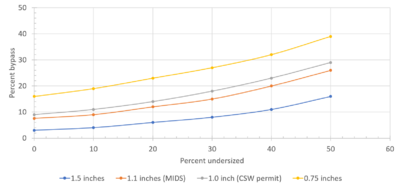
Estimating and calculating bypass for the Minimal Impact Design Standards (MIDS) Calculator
The Minimal Impact Design Standards (MIDS) Calculator can be used to design and size best management practices. Typically, bmps are designed to meet a specific performance goal, such as the 1.1 inch MIDS standard or the 1 inch requirement in the Construction Stormwater General Permit.
For infiltration practices in the calculator, runoff captured by a bmp is infiltrated. Remaining water bypasses the bmp and is not treated.
For bmps with an underdrain (tree trench, bioretention, swale main channel), some water captured by the bmp is returned to the stormwater system via the underdrain. The calculator does not differentiate between water that bypasses the bmp and water returned via the underdrain, instead assuming all this water is treated. Similarly, for non-volume bmps (constructed pond, wetland, sand filter, wet swale), the calculator does not differentiate between water that has been treated and water that bypasses the bmp, instead assuming all runoff has been treated. The concept of bypass is shown in the adjacent image. This can result in significant errors in calculations of total suspended solids (TSS) and phosphorus, with the calculator overestimating pollutant removal.
To correct this error, the BMP parameters tab on each of these seven bmps now asks the user to input a bypass %. The default is 0 percent, but this value will always be greater than 0 unless the bmp is designed to capture 100 percent of the annual runoff.
Example determinations
Using the curves in the adjacent image, below are some example determinations for percent bypass.
- A performance goal of 1.1 inches (the MIDS performance goal)
- Designed to meet the performance goal: bypass = 7.6 percent
- Undersized by 8 percent: bypass = 8.6 percent
- Undersized by 21 percent: bypass = 12.0 percent
- A performance goal of 1.0 inches (the Construction Stormwater Permit performance goal)
- Designed to meet the performance goal: bypass = 9 percent
- Undersized by 8 percent: bypass = 10.2 percent
- Undersized by 21 percent: bypass = 14.2 percent
Example illustration
| Applications and treatment capabilities for infiltration basins | ||||
| BMP | Load (lbs) | Removal (lbs) | Removal (%) | Expected removal (%) |
| Infiltration trench | 1.02 | 0.94 | 92.4 | 92.4 |
| Bioretention fully sized | 1.02 | 0.82 | 80 | 75.4 |
| Bioretention undersized | 1.02 | 0.82 | 80 | 71.0 |
We ran a scenario with an infiltration trench and two biofiltration (bioretention with an underdrain) practices. One acre of impervious surface drained to each of the bmps. The infiltration trench was designed to exactly capture the MIDS performance goal of 1.1 inches (3993 ft3 of runoff). The first biofiltration practice was also designed to capture 3993 ft3 of runoff. All of this captured runoff was routed to the underdrain (no infiltration or evapotranspiration). The second biofiltration practice was designed to capture 3000 ft3 of runoff, meaning it was undersized by 25 percent (all captured water was routed to the underdrain). The results for particulate phosphorus are shown in the adjacent table.
Results indicate the infiltration basin captures and infiltrates 92.4 percent of the annual runoff. Annual PP removal is therefore 92.4 percent. The fully sized biofiltration practice captures and treats a similar annual volume. PP removal for treated water is 80 percent. Therefore, the expected removal is 0.80 * 0.924 = 75.4 percent (80 percent of the annual treated runoff). The MIDS Calculator therefore overestimates PP by 4.6 percent for this scenario. Biofiltration practice 2, which is undersized by 25 percent, treats 87 percent of the annual runoff (as determined with the calculator). Expected removal is therefore 0.80 * 0.87 = 69.6 percent. The MIDS Calculator therefore overestimates PP by 10.4 percent for this scenario.
The User should therefore enter a bypass percent of 7.6 percent for biofiltration 1 (fully sized) and 13 percent for biofiltration 2 (undersized bmp).
This page was last edited on 12 January 2023, at 15:50.

